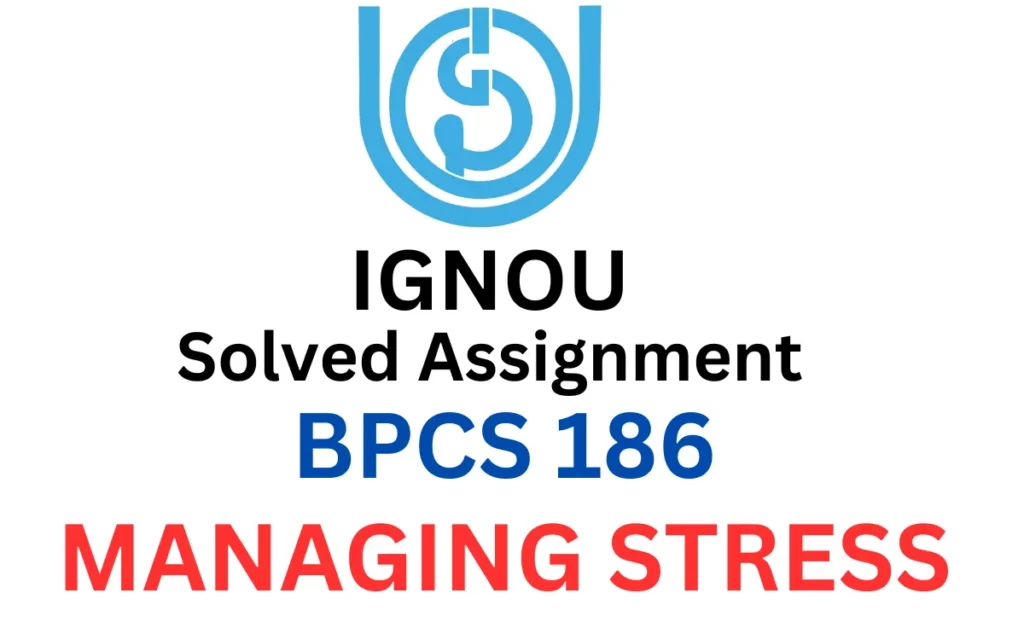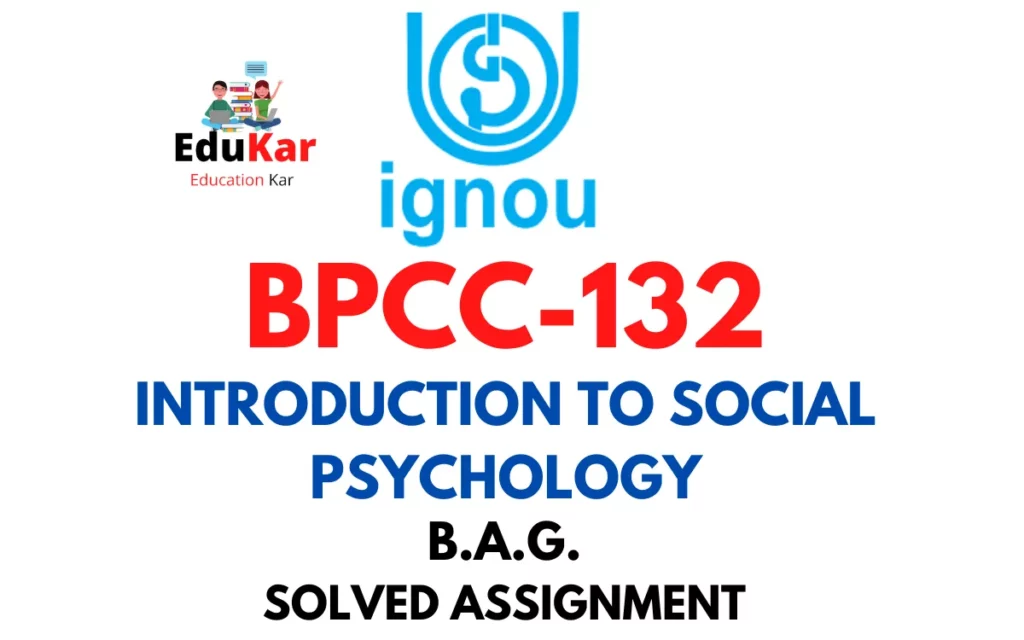Contents
- 1 Assignment One
- 2 Answer the following questions in about 500 words each.
- 3 1. Describe the nature of human resource development.
- 4 2. Explain the meaning of performance appraisal and describe its methods.
- 5 3. Explain the concept of employee engagement and describe the ways in which employee engagement can be promoted.
- 6 Assignment Two
- 7 Answer the following questions in about 100 words each.
- 8 4. Describe the functions of human resource management.
- 9 5. Elucidate globalisation.
- 10 6. Describe the uses of job analysis.
- 11 7. Explain various barriers to effective selection.
- 12 8. Elucidate the concepts of training and development.
- 13 9. Describe various factors affecting employee retention.
- 14 10. Elucidate psychological contract.
- 15 11. Describe the ways of promoting occupational safety.
Welcome to Edukar.in! Are you looking for BPCS 187-MANAGING HUMAN RESOURCES Solved assignment. So, you are at the right place. We have a collection of all the IGNOU BAG Assignments for free.
I hope this assignment helps you to score good in your exams.
| Title | BPCS 187-MANAGING HUMAN RESOURCES (IGNOU-BAG) Solved Assignments 2022-2023 |
| University | IGNOU |
| Degree | Bachelor Degree Programme |
| Course Code | BPCS 187 |
| Course Name | MANAGING HUMAN RESOURCES |
| Total Marks | 100 |
| Year | 2022-2023 |
| Language | English |
| Assignment Code | Asst /TMA /July 2022-January 2023 |
| Last Date for Submission of Assignment: | For June Examination: 31st March For December Examination: 30th September |
Assignment One
Answer the following questions in about 500 words each.
1. Describe the nature of human resource development.
Answer. Human Resource Development (HRD) refers to the process of improving and enhancing the skills, knowledge and abilities of employees through training, education and development programs. It is an integral part of human resource management and focuses on improving the performance and potential of employees in order to meet the organizational goals and objectives.
Nature of HRD:
- Holistic approach: HRD takes into account the entire organization and its environment and seeks to develop the employees in a comprehensive and integrated manner.
- Long-term perspective: HRD is not just about addressing short-term issues but also developing employees for the long term in order to create a sustainable workforce.
- Development-oriented: HRD is focused on employee development, not just training. It seeks to develop employees’ skills, knowledge, and abilities in order to enhance their performance and potential.
- Employee-centered: HRD is centered on the needs and development of employees, not just the organization. This focus on employee development helps to increase employee engagement and satisfaction.
- Continuous process: HRD is not a one-time event but a continuous process that evolves over time as the needs of the organization and employees change.
- Collaborative: HRD involves collaboration between employees, managers, HR professionals, and other stakeholders to ensure that development programs are effective and meet the needs of all parties.
Benefits of HRD:
- Improved employee performance: By developing employees’ skills and abilities, HRD can help to improve overall employee performance and contribute to the success of the organization.
- Increased employee engagement: When employees feel that their employer is investing in their development, they are more likely to feel valued and engaged with their work.
- Better employee retention: Employees are more likely to stay with an organization that invests in their development and provides opportunities for growth and advancement.
- Improved organizational competitiveness: A well-developed workforce can help organizations to remain competitive and meet the challenges of a rapidly changing business environment.
- Increased innovation: HRD can help to develop employees’ critical thinking skills and creativity, leading to increased innovation and problem-solving.
- Better alignment with organizational goals: By developing employees who are aligned with the goals and values of the organization, HRD can help to create a more cohesive and effective workforce.
HRD Methods:
- On-the-job training: Employees learn new skills and knowledge while performing their daily tasks.
- Formal training: Formal training programs are structured and often delivered by external trainers.
- Coaching and mentoring: Employees receive guidance and support from more experienced colleagues in order to develop their skills and knowledge.
- Career development programs: Career development programs help employees to plan their careers and identify opportunities for growth and advancement.
- E-learning: Online training programs allow employees to access training materials and resources at their own pace and convenience.
In conclusion, HRD plays a critical role in the success of organizations by developing employees and enhancing their performance and potential. It is a continuous process that requires collaboration between employees, managers, and HR professionals to ensure that development programs are effective and meet the needs of all parties.
2. Explain the meaning of performance appraisal and describe its methods.
Answer. Performance appraisal is the process of evaluating an employee’s job performance and providing feedback to the employee about their strengths and areas for improvement. This feedback is used to help employees understand their performance, identify areas for improvement, and set goals for future performance.
Meaning of Performance Appraisal: Performance appraisal is a systematic way of evaluating an employee’s job performance over a specific period of time. It involves evaluating both the quality and quantity of work performed by the employee, and provides an opportunity for the employee to receive feedback about their performance. The purpose of performance appraisal is to help employees improve their performance and develop their potential, as well as to support the overall goals of the organization.
Benefits of Performance Appraisal:
- Improved employee performance: By providing employees with regular feedback about their performance, performance appraisal can help employees to understand their strengths and areas for improvement, and to make changes to improve their performance.
- Better employee development: Performance appraisal provides employees with an opportunity to receive feedback about their performance and to set goals for future development.
- Improved communication: Performance appraisal helps to improve communication between employees and their managers, by providing a regular forum for discussion and feedback.
- Improved organizational performance: By evaluating and improving employee performance, performance appraisal can help organizations to improve overall performance and meet their goals and objectives.
- Improved motivation: By providing employees with regular feedback about their performance, performance appraisal can help to increase employee motivation and engagement.
Methods of Performance Appraisal:
- Traditional methods: Traditional performance appraisal methods include rating scales, forced ranking, and graphic rating scales. These methods provide a structured way of evaluating employee performance and are often used in combination with other methods.
- 360-degree feedback: 360-degree feedback involves evaluating an employee’s performance from multiple perspectives, including from their manager, peers, and subordinates.
- Self-appraisal: Self-appraisal involves the employee evaluating their own performance, and comparing it to their manager’s evaluation. This method provides employees with an opportunity to reflect on their performance and to receive feedback from their manager.
- Assessment centers: Assessment centers involve evaluating an employee’s performance through a variety of exercises and simulations, including role-playing, case studies, and group discussions.
- Behavioral observation scales: Behavioral observation scales involve observing an employee’s behavior and rating it against specific behaviors and standards.
In conclusion, performance appraisal is a critical aspect of human resource management that provides employees with feedback about their performance and helps organizations to improve overall performance. By using a variety of methods, organizations can ensure that performance appraisal is a comprehensive and effective tool for evaluating and improving employee performance.
3. Explain the concept of employee engagement and describe the ways in which employee engagement can be promoted.
Answer. Employee engagement refers to the level of emotional and psychological connection that employees have to their work and their organization. Engaged employees are highly motivated, dedicated, and invested in their work, and they are more likely to be productive, stay with their organization for a longer period of time, and provide high-quality work.
Concept of Employee Engagement: Employee engagement is a complex concept that encompasses a range of factors, including job satisfaction, organizational commitment, and employee well-being. Engaged employees are those who are deeply involved in their work, feel a sense of connection to their organization, and are motivated to contribute to its success.
Benefits of Employee Engagement:
- Increased productivity: Engaged employees are more productive and produce higher-quality work, resulting in improved organizational performance.
- Lower turnover: Engaged employees are less likely to leave their organization and are more likely to stay for a longer period of time, resulting in reduced costs associated with turnover and recruitment.
- Improved customer satisfaction: Engaged employees are more likely to provide high-quality customer service, resulting in improved customer satisfaction.
- Improved financial performance: Engaged employees are more likely to contribute to improved financial performance, as they are more productive, provide high-quality work, and are less likely to leave the organization.
Ways to Promote Employee Engagement:
- Communication: Encouraging open, transparent communication between employees and management is critical to promoting employee engagement.
- Recognition and rewards: Recognizing and rewarding employees for their contributions and achievements can help to increase employee engagement and motivation.
- Career development: Providing employees with opportunities for career development and growth can help to increase engagement and motivation, as employees feel that they have a future with the organization.
- Work-life balance: Providing employees with flexible work arrangements and support for work-life balance can help to increase engagement and reduce stress and burnout.
- Employee involvement: Encouraging employee involvement in decision-making and problem-solving can help to increase engagement, as employees feel that they have a voice and a role in the success of the organization.
- Health and well-being: Promoting employee health and well-being through programs such as wellness initiatives, stress management programs, and support for mental health can help to increase engagement and reduce stress and burnout.
In conclusion, employee engagement is a critical aspect of organizational success, as engaged employees are more productive, provide high-quality work, and are less likely to leave the organization. By promoting communication, recognition and rewards, career development, work-life balance, employee involvement, and health and well-being, organizations can create a culture of engagement and support the success of their employees and the organization.
Assignment Two
Answer the following questions in about 100 words each.
4. Describe the functions of human resource management.
Answer. The functions of human resource management (HRM) include recruiting and hiring employees, training and development, managing employee benefits, performance appraisal and management, and ensuring compliance with labor laws and regulations. HRM also plays a key role in creating and maintaining a positive organizational culture and managing employee relations. Other functions of HRM include compensation and benefits administration, employee health and safety, and conflict resolution. By performing these functions effectively, HRM helps organizations to attract, retain, and develop talented employees, and to create a positive, productive work environment that supports organizational success.
5. Elucidate globalisation.
Answer. Globalization refers to the increasing interconnectedness and interdependence of the world’s economies, societies, and cultures. This process is driven by advances in technology, transportation, and communication, as well as increased trade and investment. As a result of globalization, goods, services, capital, and people are able to move more freely across borders. This process has led to increased economic growth, improved living standards, and increased cultural exchange, but it has also led to challenges such as income inequality, cultural homogenization, and environmental degradation. The effects of globalization are complex and can be both positive and negative, depending on the perspective.
6. Describe the uses of job analysis.
Answer. Job analysis is the process of collecting and analyzing information about the duties, tasks, and responsibilities associated with a specific job. This information is used for a variety of purposes, including:
- Recruitment and selection: Job analysis is used to determine the knowledge, skills, and abilities required for a specific job, which is useful in developing job descriptions and selection criteria.
- Performance appraisal: Job analysis is used to determine the specific tasks and responsibilities associated with a job, which is useful in evaluating employee performance and providing feedback.
- Training and development: Job analysis is used to determine the training and development needs of employees, so that training programs can be designed and delivered to meet those needs.
- Compensation and benefits: Job analysis is used to determine the relative worth of different jobs, so that compensation and benefits can be equitably determined and managed.
- Legal compliance: Job analysis is used to ensure that job requirements are job-related and non-discriminatory, which is important in avoiding legal challenges related to discrimination and equal employment opportunity.
In summary, job analysis is a valuable tool for organizations, as it provides information that is used to make informed decisions related to recruitment and selection, performance appraisal, training and development, compensation and benefits, and legal compliance. By conducting job analysis, organizations can ensure that their jobs are designed and managed in a way that supports organizational success and meets the needs of employees and the organization.
7. Explain various barriers to effective selection.
Answer. There are several barriers to effective selection, including:
- Lack of job analysis: Without a clear understanding of the duties, responsibilities, and requirements of a job, it is difficult to select the most qualified candidates.
- Unreliable selection tools: The use of unreliable selection tools, such as personality tests or subjective interviews, can lead to selection decisions that are not based on actual job performance.
- Bias: Selection bias can occur when individuals are not selected based on merit, but rather on factors such as race, gender, or age.
- Inadequate candidate pool: If the pool of candidates is not diverse or if there is a shortage of qualified candidates, it can be difficult to find the right person for the job.
- Cost: The cost of conducting selection tests and assessments can be a barrier, particularly for small organizations.
- Time constraints: The pressure to fill positions quickly can lead to shortcuts in the selection process, which can result in poor hiring decisions.
By recognizing and addressing these barriers, organizations can ensure that they select the best candidate for the job, which is essential for organizational success.
8. Elucidate the concepts of training and development.
Answer. Training and development refer to the process of improving the knowledge, skills, and abilities of employees in order to enhance their performance and meet the needs of the organization. Training involves teaching employees specific skills, while development focuses on broader, long-term growth and career advancement. Both training and development can take place through various methods, such as on-the-job training, workshops, classroom training, and mentorship programs. Effective training and development programs can lead to increased employee satisfaction, improved job performance, and increased productivity. Additionally, they can help organizations to attract and retain talented employees, and to build a skilled and capable workforce that supports the achievement of organizational goals and objectives.
9. Describe various factors affecting employee retention.
Answer. Employee retention is affected by a number of factors, including job satisfaction, compensation and benefits, workplace culture, opportunities for growth and development, work-life balance, clear communication and expectations, recognition and rewards, and trust in leadership. Additionally, employee morale and job security, the level of support and resources provided, and the overall health and well-being of employees can also play a role in their decision to stay with a company. The management style, company values, and the level of diversity and inclusion can also impact employee satisfaction and ultimately influence their decision to remain with the organization.
10. Elucidate psychological contract.
Answer. The psychological contract is an unwritten agreement between an employer and an employee that outlines the expectations and obligations of both parties. It includes perceptions of promises, obligations, and expectations regarding the reciprocal exchange of contributions, rewards, and support between the employer and employee. The psychological contract is shaped by past experiences, organizational culture, communication, and individual needs and values. A positive psychological contract can lead to increased job satisfaction, commitment, and employee retention, while a negative contract can result in decreased motivation and turnover intentions. It is important for organizations to regularly assess and communicate the terms of the psychological contract to maintain a positive and productive relationship with employees.
11. Describe the ways of promoting occupational safety.
Answer. Promoting occupational safety involves creating a safe and healthy work environment to prevent accidents and injuries. This can be achieved through several methods, including:
- Developing and implementing safety policies and procedures
- Providing safety training and education for employees
- Conducting regular safety inspections and audits
- Maintaining proper equipment and facilities maintenance
- Encouraging employee participation in safety programs
- Implementing ergonomic solutions to reduce physical strain
- Encouraging reporting of near misses and accidents
- Recognizing and rewarding safe behavior
- Conducting risk assessments and implementing control measures
- Regularly reviewing and updating safety policies to ensure they are current and effective.
By implementing these measures, organizations can reduce the risk of workplace accidents and injuries and create a culture of safety.
How to Download BPCS 187-MANAGING HUMAN RESOURCES Solved Assignment?
You can download it from the www.edukar.in, they have a big database for all the IGNOU solved assignments.
Is the BPCS 187-MANAGING HUMAN RESOURCES Solved Assignment Free?
Yes this is absolutely free to download the solved assignment from www.edukar.in
What is the last submission date for (IGNOU-BAG) Solved Assignment?
For June Examination: 31st March, For December Examination: 30th September


![[Solved Assignment] BPCS 185-DEVELOPING EMOTIONAL COMPETENCE (IGNOU-BAG) 2022-2023 [Solved Assignment] BPCS 185-DEVELOPING EMOTIONAL COMPETENCE (IGNOU-BAG) 2022-2023](https://edukar.org/wp-content/plugins/contextual-related-posts/default.png)











